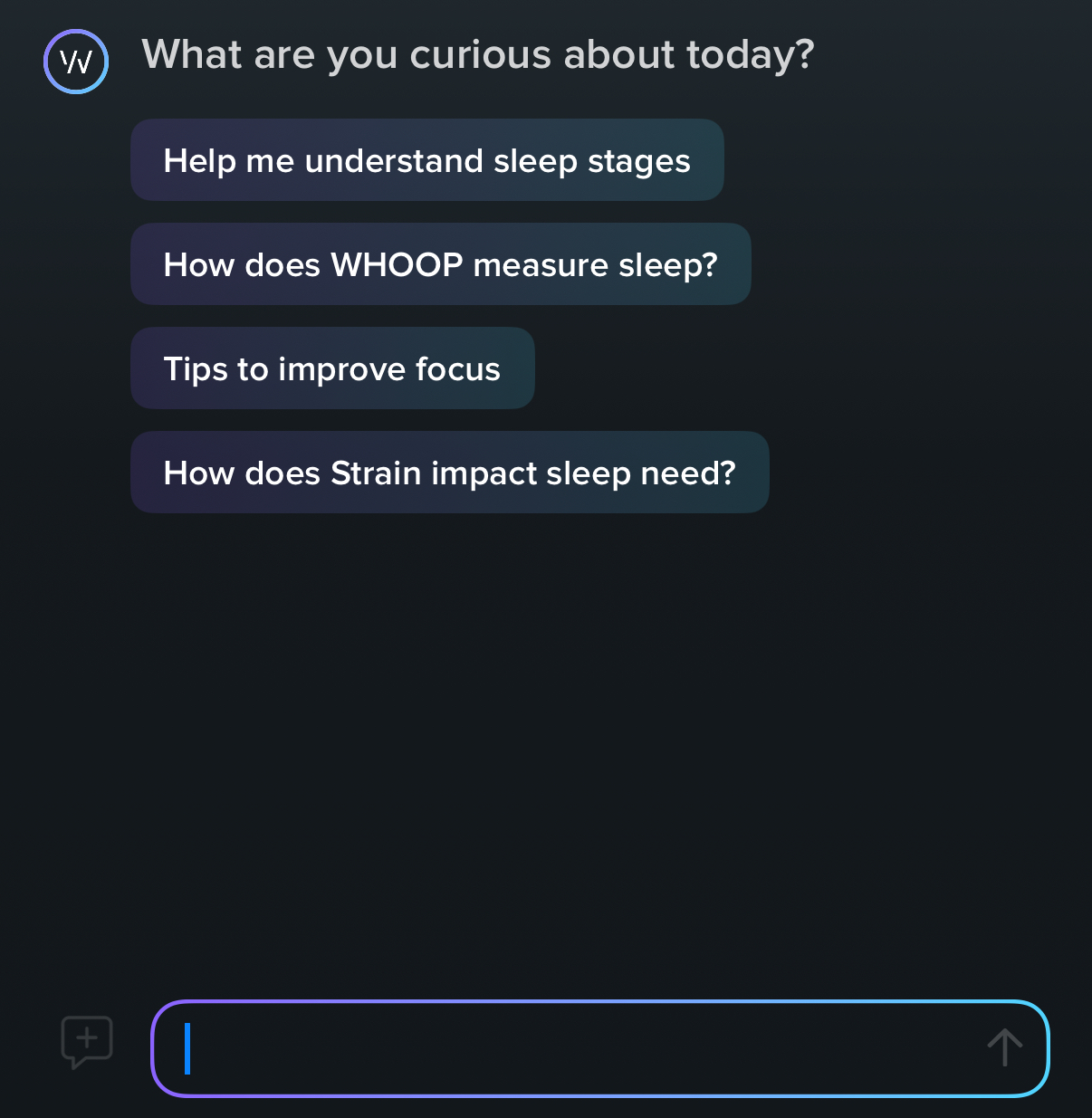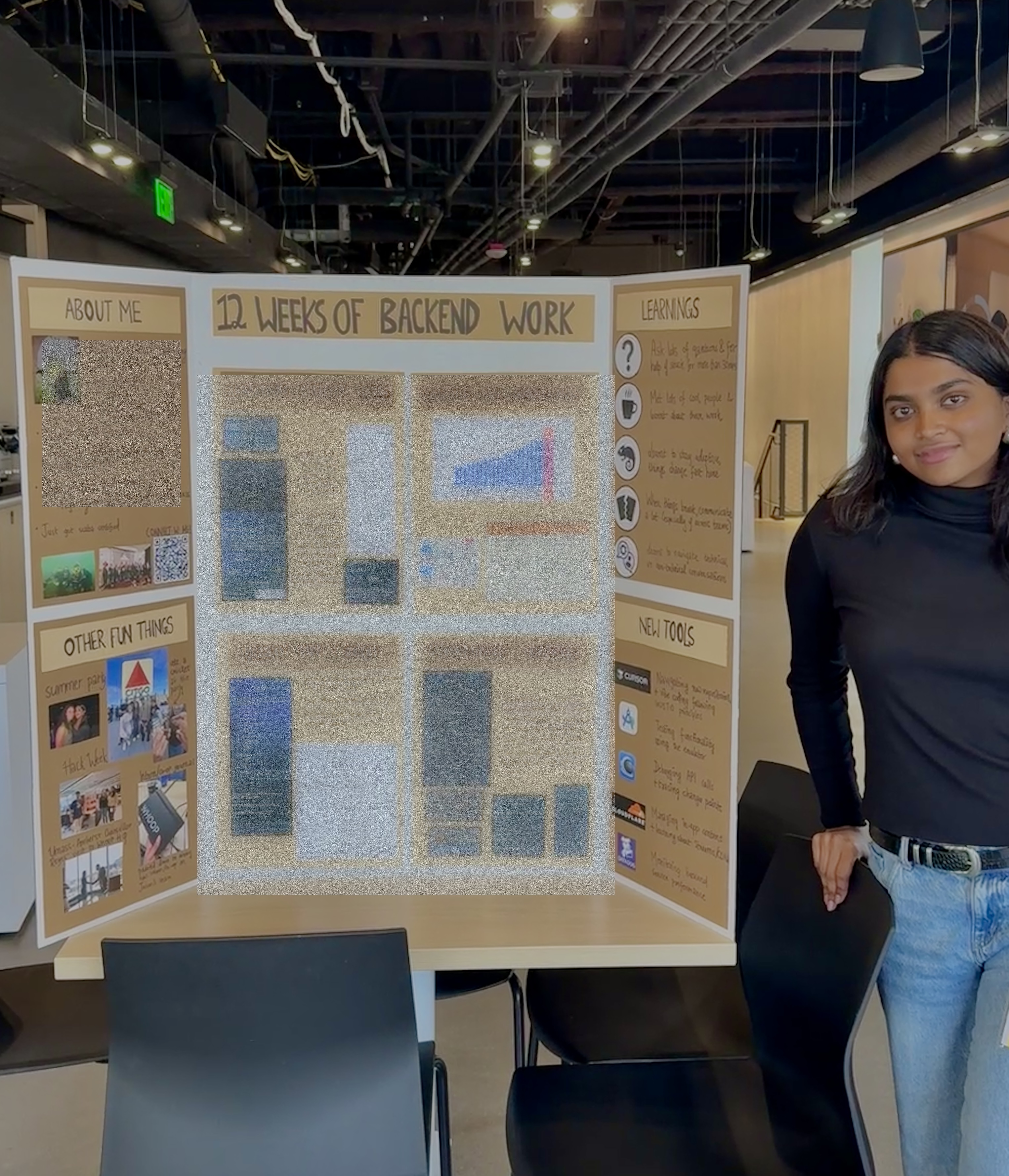Internships and Co-ops at WHOOP are more than working on temporary projects - they give students the chance to ship real work, explore new technologies, and see their impact firsthand. In the reflections that follow, two interns share their journeys: one as a college SWE intern building core product features, and another as a high school SWE intern who transformed an idea into a redesigned engineering blog. Together, their stories highlight how WHOOP empowers interns and co-ops of all backgrounds to learn, build, and belong.
What WHOOP Taught Me About Building & Belonging by Arna Bhattacharya
When I joined WHOOP as a Software Engineer intern this summer, I was hoping to build cool features and become a better engineer. And what surprised me the most wasn't the work itself, but how fully I was brought into the team.
From my very first week, I was opening PRs, shipping code, and participating in the same workflows as full-time engineers. I learned how real software gets built — through collaboration, iteration, and accountability. There were no intern "training wheels" or isolated side projects. I truly felt like a teammate, a feeling that changed everything.
And because everyone at WHOOP wears the product, that sense of ownership extends beyond engineering. I wasn’t just writing code. I was wearing the band, checking my metrics, and engaging with the app daily. I could feel the impact of the work I was doing, because I was living it.
Using the product every day made me look at my work not as tasks on a checklist, but as contributions with real impact. This made me more thoughtful, motivated, and confident in my ability to grow into a full-time role. That confidence felt especially important in a world where technology is evolving fast and the role of an engineer is constantly changing.
How WHOOP Is Surfing the GenAI Wave
When I started college three years ago, generative AI wasn’t a part of the conversation. By the time I was done with freshman year, ChatGPT had launched publicly and everything changed. Even last year, using GenAI tools in production was seen as reckless or controversial.
Now? You’re expected to know how to utilize GenAI. Whether it’s pair-programming with LLMs or prototyping ideas, modern developers are navigating a completely different landscape than the one I started studying for. And the pace only seems to be accelerating.
For the first two months of my internship, I was part of the Coaching Task Force—a software team focused on building new member experiences using WHOOP Coach, our GenAI-powered assistant available to all members. While we weren’t building the core chatbot itself, our work extended its capabilities. This meant working directly with large language models in production, designing for real users, and thinking deeply about how to combine GenAI with WHOOP’s core principles.
What stood out most was WHOOP’s culture around AI. We're not just building on these tools. We are actively using them. There is a strong encouragement to experiment, adopt, and evolve. Given how rapidly everything is changing across the industry, I think this mindset is necessary. And it makes me genuinely excited for what the future of engineering looks like.

Hack Week: A Startup Within a Startup
One of the most memorable parts of the summer was Hack Week. We had full freedom to work on whatever we wanted. It was intense, exciting, and real. We weren’t just hacking for fun; we were building features we personally wanted WHOOP to have. It was like building a startup within a startup.
You didn’t need to be on a technical team to participate, everyone was invited to build. At the end, we held a science fair–style showcase where 72 teams from across the company came together to present what they built.
That week showed me how deeply WHOOP values experimentation. Whether you are an engineer or a designer or a marketer (or an intern like me), your voice and ideas matter. Everyone has something to build.
A Culture That’s Curious, Connected, and (Honestly) Fun
One of my favorite WHOOP rituals is the “coffee chat” perk: every time you meet someone new, you can get a coffee or lunch with them through the company. It might sound small, but it made it so easy to reach out and connect. These 1:1 interactions taught me so much about the company, people across departments, and even myself.
The strong interdisciplinary and social culture could also be seen during WHOOP’s end of internship presentations. These presentations weren’t just slide decks shared with your department. Instead, we had a poster fair where interns from all departments presented together. Just like Hack Week, software folks stood right next to marketers, hardware folks next to analysts. It was a shared space where everyone got to celebrate each other’s work.
That sense of community, of being part of something bigger than just your team, is something I’ll carry with me. It’s easy to underestimate how much culture shapes your experience until you’re at a place that gets it right.

What I’ll Take With Me
Before this summer, I thought I knew what kind of engineer I wanted to be. Now I know what kind of environment I want to grow in. I want an environment where I’m encouraged to learn. A place where people are hungry to try new technologies, to experiment without fear, and move fast without forgetting to think deeply.
WHOOP has shown me that such a place exists. Although I still have a year left of school, I’m leaving this internship feeling so much closer to being ready for the next chapter.
From Classroom to Office: My Journey at WHOOP by Jacob Friedman
I've always been fascinated by fitness data, so having the opportunity to work at a company like WHOOP was obvious. WHOOP is a fast-paced tech company where new ideas grow, and everyone can make a real difference. In just under a month, I went from a nervous high-school intern to launching a brand-new blog experience that now showcases WHOOP engineers to the best of their ability. I was guided every step of the way by my mentor, Mark Flores. I learned how initiative, and a good night's sleep, can turn classroom theory into real-world impact.
Landing & Learning: My Role in a Nutshell
At first I was tasked with various research projects, investigating AI events where WHOOP could potentially attract new engineering talent. Then, I investigated how WHOOP's engineering blog page could be visually improved as it was using a default theme. Once all of my coding applications had been set up, it was time to get to work. My mission was simple yet ambitious: to take ownership of the engineering blog experience and make it easier for readers to discover our team's stories.
During the first week, I worked on various small improvements, which walked me through the entire release pipeline from local commits to production deployment. Slack channels and Cursor agent quickly became my go-to tools for unblocking questions and accelerating learning. Mark would always devote time to explain concepts and remind me that "no question is too small", which made my learning experience feel safe and rapid.
The Signature Build: Re-designing /blog
 Before and after: From endless scroll to organized postcard grid layout
Before and after: From endless scroll to organized postcard grid layout
The blog page used to be an endless scroll, making it hard for readers to navigate through content efficiently. I tackled this by building a new postcard-style grid with captivating cover images, and using AI to generate art when needed. I tested it thoroughly on a safe route before swapping it into production, ensuring no existing URLs broke.
Early on, Cursor suggested using swizzle eject—which basically forks theme components into your repo—making upgrades brittle, blocking upstream bug/security fixes, and creating a long-term maintenance headache. Instead, I passed on that approach and looked for safer methods, building a custom page and overriding only what was necessary so future updates stay smooth.
After consulting with Mark, he suggested reaching out to other co-workers for their opinions. I found this intimidating at first as I had never spoken to them before. Just a few minutes after reaching out, I was provided with amazing advice which led me to decide to build a new custom page instead of trying to alter an existing page. This was a critical breakthrough in the process as it allowed me to work freely on a completely custom page.
When the redesign finally shipped, we saw an immediate spike in post clicks. Our Slack channel erupted with celebratory emojis and a special note from Mark.
Growth Spurts & Mentorship
Being able to master time management was a skill that was essential as it helped me set clear daily goals, which turned constant task switching to steady focused progress. After my second successful release, I realized I had made real contributions to the company and was beginning to prove myself capable of the position.
Mark wanted me to learn as quickly as possible and this pushed me to proactively ask more questions and complete tasks with independence and not constantly ask for approval. Furthermore, there was an intern/co-op panel that showed me how the short-term projects I was working on can evolve into long-term careers, which really widened my sense of possibilities and my perspective.
Lessons & Playbook for Future Interns
Through my experience, I've developed a playbook that I hope will help future interns make the most of their time:
- Do not let your title or age limit your willingness to push code - initiative is what truly drives impact.
- After attempting to unblock yourself, ask for help if you're still stuck - there's no shame in seeking guidance.
- Before committing any AI-generated code changes, always double-check them - trust but verify.
- Treat every one-on-one with your mentor like office hours and capture at least one key takeaway each time.
- Celebrate small wins loudly - each merged pull request is a stepping-stone toward bigger responsibilities.
Looking Forward & Impact
Ultimately, I hope the postcard layout continues to surface great stories—or inspires someone to build an even better version. A year from now, I would love to hear that new interns still reference my project when they learn the release pipeline.
Mark's belief in me transformed a nervous teenager into a confident contributor. I intend to pay that mentorship forward by making team members feel welcome and fostering a sense of belonging and contribution, ensuring their work is meaningful and impactful, just as I experienced at WHOOP.
My north star is to keep working with mission-driven companies where shipped code directly improves people's performance and well-being.